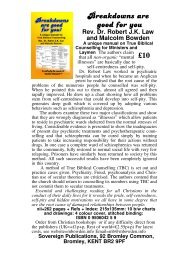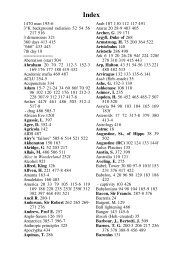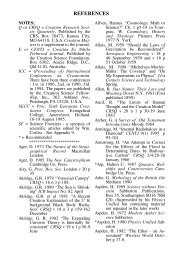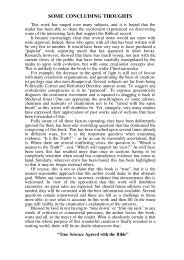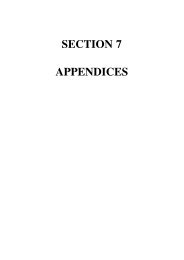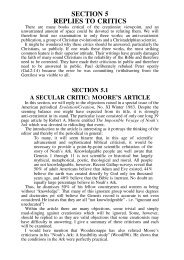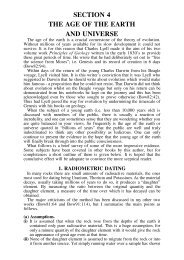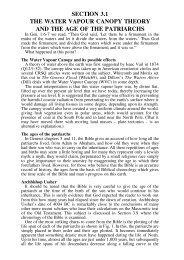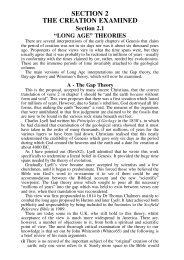TSAWTB Section 6 - Interlude - A Miscellany of Items
True Science Agrees with the Bible, Section 6 - Interlude - A Miscellany of Items (pp. 250-288)
True Science Agrees with the Bible, Section 6 - Interlude - A Miscellany of Items (pp. 250-288)
You also want an ePaper? Increase the reach of your titles
YUMPU automatically turns print PDFs into web optimized ePapers that Google loves.
262 <strong>Section</strong> 6 - <strong>Interlude</strong><br />
In his introduction to this, Fawkes describes the person as “the lady who had<br />
nursed Darwin”, but then describes her as one who “had been in attendance”.<br />
Moore contends this is Lady Hope, but Cr<strong>of</strong>t says it is probably a Mrs. Evans<br />
who “had been with the Darwin household as a nurse for many years”.<br />
(Another writer says she was the cook. Actually she was the old housekeeper).<br />
Which is correct - was it Lady Hope or a lady in the house?<br />
In her account Lady Hope was not asked to read to him and she does not<br />
mention a specific hymn he requested. Cr<strong>of</strong>t notes that Mrs. Evans was a<br />
member <strong>of</strong> the Gospel Room congregation and could easily arrange for the<br />
children to sing. However, there is no record <strong>of</strong> this taking place.<br />
The crucial point is not who this lady was, but that Nicholls heard <strong>of</strong><br />
Darwin’s change. If it was Lady Hope, then he must have heard <strong>of</strong> this soon<br />
after the event as probably she was not in the area for long. If it was another<br />
lady, then this would be a totally independent witness from Lady Hope.<br />
Nicholls’ account is so close to Darwin’s home that it gives support to the<br />
story, no matter by what route it came to him.<br />
(C) Sir Robert Anderson<br />
One <strong>of</strong> the most interesting references Moore mentions involves Sir Robert<br />
Anderson who was the head <strong>of</strong> the C.I.D. at Scotland Yard during the time <strong>of</strong><br />
the investigation <strong>of</strong> the “Jack the Ripper Murders”. He was a well known<br />
evangelical, and a very close friend <strong>of</strong> Lady Hope. Obviously referring to Lady<br />
Hope, he wrote as early as 1907:<br />
..a friend <strong>of</strong> mine who was much with Darwin during his last<br />
illness assures me that he expressed the greatest reverence for the<br />
scriptures and bore testimony to their value (M:48).<br />
This is an important comment which we discuss later.<br />
3. There were accounts circulating unconnected with her<br />
Moore gives several <strong>of</strong> these incidents.<br />
(A) May 1882 - only eight months after her visit and one month after<br />
Darwin’s death in April. A preacher, Mr. Huntingdon, at Tenby refers to<br />
Darwin “in his last utterances confessed his true faith.” Tenby “had been the<br />
home <strong>of</strong> Emma Darwin’s (Charles’s wife) Allen aunts; the Darwin’s first<br />
cousin, the Rev. John Allen Wedgewood, still lived there.”<br />
Moore (p71) speculates that “perhaps clerical chit-chat got worked into the<br />
sermon”. This is an interesting account, for, chit-chat or not, here we have a<br />
direct connection between the Darwin family and a report <strong>of</strong> a “recantation”,<br />
and Lady Hope is not involved. If Huntingdon had fabricated his anecdote,<br />
his close neighbour would surely have heard <strong>of</strong> it and sharply corrected the<br />
record. This is surely <strong>of</strong> some value as independent evidence that there had<br />
been a “recantation” <strong>of</strong> some sort!<br />
(B) September 1882. Robert Eadie F.R.G.S. is said to have sent to the<br />
Darwin family, who were collecting his letters for publication, a note he had<br />
received from Darwin in which he said that “he [Darwin] can with confidence<br />
look to Calvary”. No letter from Eadie ever appeared in the published letters<br />
<strong>of</strong> Darwin (M:73) - which is not surprising in view <strong>of</strong> its explosive content.<br />
(C) 1928. Ivor Panin (See Appendix 7) received information by a circuitous<br />
route that an Oxford pr<strong>of</strong>essor had received a letter from Darwin, whom he<br />
claimed was a close friend, saying he had become a firm Christian. The<br />
pr<strong>of</strong>essor had commented that, “The position is odd as both his son and<br />
grandson deny his Christianity” (M:85). His acknowledgement that the letter



